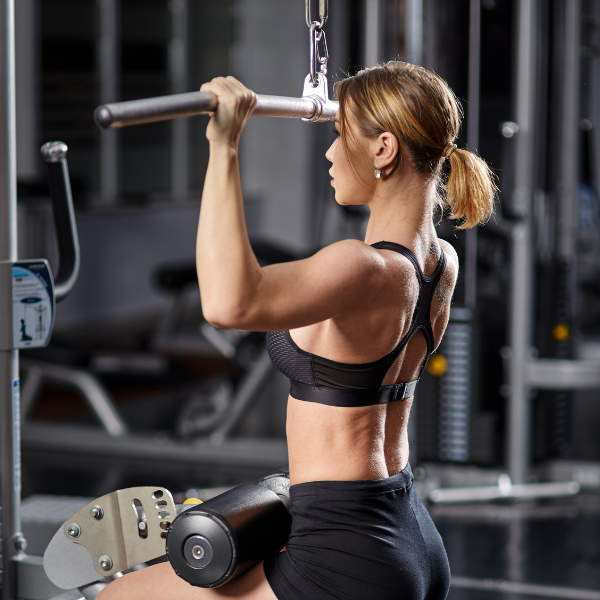Whether you're a seasoned athlete or a fitness enthusiast, mastering the lat pulldown is crucial for developing a strong and sculpted back.
The lat pulldown is more than just pulling weight; it's about engaging the right muscles with the correct technique.
In this guide, we'll explore how optimizing your grip can lead to better performance and more impressive results. Let's look closely at lat pulldowns and unlock the potential of your back workouts.
Understanding the Importance of Lat Muscles
Our back is a complex tapestry of muscles, with the latissimus dorsi—or lats—playing a starring role.
These broad, wing-like muscles sweep down from under your arms to the lower back, creating that coveted V-taper.
The lats are important for movements such as reaching, pulling, and standing straight.
A strong latissimus dorsi supports your spine and shoulders, making it essential for aesthetics, functional strength, and stability.
Proper Grip Techniques for Lat Pulldowns
Wide Grip vs. Narrow Grip

When it comes to lat pulldowns, grip width can significantly influence muscle activation. A wider grip emphasizes the upper lats, broadening that V-taper, while a narrow grip shifts the focus slightly toward the lower lats and can also engage the biceps more intensively.
Choose your grip according to your specific goals or incorporate different variations into your routine to reduce the risk of muscle imbalance.
Overhand vs. Underhand Grip

The orientation of your grip changes the way your muscles are recruited during the lat pulldown.
With an overhand grip, there's a greater emphasis on the upper back muscles, including the posterior deltoids and the trapezius. Switch to an underhand grip, and you'll feel it more in the lower lats and the biceps brachii.
Both grips are effective, so alternating between them can provide a workout that targets the back from multiple angles.
Lat Pulldown Variations for Maximum Results
To keep your back workouts dynamic and effective, it's essential to incorporate various lat pulldown exercises. You can target the latissimus dorsi by tweaking your grip from different angles, promoting greater muscle growth and strength.
Let's look at a couple of variations that can help you achieve maximum results.
Reverse-Grip Pulldowns

Reverse-grip pulldowns (or supinated-grip pulldowns) are an excellent way to add diversity to your lat training. This variation involves flipping your grip so that your palms face toward you.
An underhand grip activates the lower lats and engages the biceps brachii muscle more effectively. This grip allows for a greater range of motion and can increase muscle activation, especially when you squeeze your shoulder blades together at the bottom of the movement.
Close-Grip Pulldowns

Close-grip pulldowns engage the middle trapezius, rhomboids, and lats. By bringing your hands closer, you activate muscles from a different angle, which is crucial for overall back development. This variation targets the area between your shoulder blades, improving posture.
Remember to keep your torso straight and pull the bar down to your upper chest to maximize the effectiveness of the exercise.
Common Mistakes to Avoid in Lat Pulldowns
While lat pulldowns are a staple in back-building routines, they are often performed incorrectly. Here are some common mistakes to avoid:
-
Incorrect Grip Width: A grip too wide or narrow can stifle muscle work and invite shoulder pain. Your grip should jive with your body's natural structure.
-
Excessive Leaning: Leaning too far back is a no-go. Stay mostly upright with just a bit of lean to pinpoint those lats without overloading your lower back.
-
Bar in Back: Yanking the bar behind your head is a risky move for your shoulders and neck. Keep it to the front, aiming for the upper chest.
-
Lack of Control: Don't just let the weight crash down—ease it back slowly. This amps up muscle engagement and cuts injury risk.
-
Restricted Range of Motion: Skimping on the stretch or the squeeze sells your lats short. Go for full arm extension and bring the bar all the way down to your chest.
You'll optimize your lat pulldown performance by avoiding these mistakes and focusing on proper form for better muscle growth and strength gains.
Enhancing Your Lat Pulldown Workouts with Accessories
Gaspari Premium Lifting Straps

Gaspari Premium Lifting Straps are your go-to accessory if you struggle with grip fatigue during heavy sets. Designed to reduce discomfort and enhance grip strength, these padded neoprene straps allow you to tackle any amount of weight easily.
Gaspari Nutrition's straps are especially useful for pulling movements like deadlifts, rows, and lat pulldowns. By securing a firm grip, you can concentrate on activating those lats and other back muscles without the worry of slipping or tugging.
FAQ: Lat Pulldown Grip and Technique
Can beginners perform lat pulldowns?
Absolutely! Lat pulldowns are a fantastic exercise for beginners looking to build strength in their back muscles. It's a controlled movement that can be performed with light weight to start, allowing for focus on proper form and technique. Beginners should prioritize mastering the movement pattern with a comfortable grip width before progressing to heavier weights.
What other exercises can help build my lats?
Besides lat pulldowns, other exercises effectively target the latissimus dorsi. Pull-ups, barbell bent-over rows, and single-arm dumbbell rows engage the lats intensely. For isolation, try dumbbell pullovers and seated cable rows with various grips. Diversify your routine with different movements and angles for a sculpted V-taper appearance.













































































Share:
Unlocking Muscle Growth Potential: Understanding Occlusion Training
High Intensity Training: Unlocking Muscle Growth through Strategic Failure